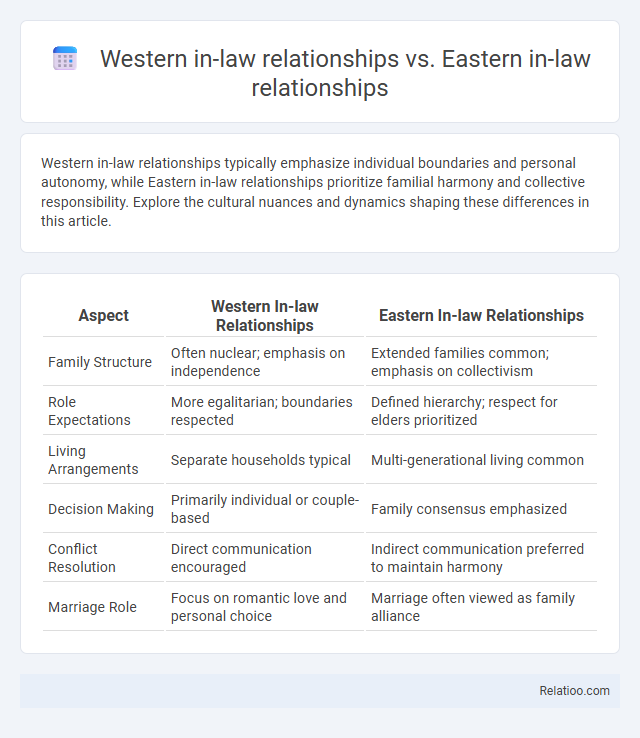Western in-law relationships typically emphasize individual boundaries and personal autonomy, while Eastern in-law relationships prioritize familial harmony and collective responsibility. Explore the cultural nuances and dynamics shaping these differences in this article.
Table of Comparison
| Aspect | Western In-law Relationships | Eastern In-law Relationships |
|---|---|---|
| Family Structure | Often nuclear; emphasis on independence | Extended families common; emphasis on collectivism |
| Role Expectations | More egalitarian; boundaries respected | Defined hierarchy; respect for elders prioritized |
| Living Arrangements | Separate households typical | Multi-generational living common |
| Decision Making | Primarily individual or couple-based | Family consensus emphasized |
| Conflict Resolution | Direct communication encouraged | Indirect communication preferred to maintain harmony |
| Marriage Role | Focus on romantic love and personal choice | Marriage often viewed as family alliance |
Cultural Foundations of In-Law Relationships
Western in-law relationships often emphasize individualism and boundaries, prioritizing personal space and autonomy within familial interactions. Eastern in-law relationships are deeply rooted in collectivist values, highlighting respect, hierarchy, and interdependence among family members. Understanding these cultural foundations helps you navigate differing expectations and fosters harmony in diverse family dynamics.
Family Hierarchies: East vs. West
Western in-law relationships tend to emphasize egalitarian family dynamics, where boundaries between in-laws are more flexible and less hierarchical. In contrast, Eastern in-law relationships often reflect rigid family hierarchies, with younger members expected to show deference and obedience to elder in-laws, reinforcing traditional roles and respect for authority. These contrasting approaches shape the degree of influence, expectations, and communication patterns within family structures across cultures.
Expectations of Parental Involvement
Western in-law relationships typically emphasize individual autonomy, with less expectation of parental involvement in the couple's daily life, prioritizing privacy and independence. Eastern in-law relationships often involve higher expectations of parental involvement, reflecting collectivist values where extended family plays a central role in decision-making and household dynamics. In-law relationships generally vary widely, but the key distinction lies in cultural norms around parental participation, with Eastern cultures favoring active engagement and Western cultures encouraging boundaries.
Marriage as an Individual vs. Collective Union
Western in-law relationships often emphasize marriage as an individual union, highlighting personal autonomy, mutual consent, and nuclear family independence. Eastern in-law relationships typically view marriage as a collective union, where extended family ties, social obligations, and intergenerational harmony strongly influence marital dynamics. In-law relationships thus reflect cultural values: Western models prioritize individualism and personal choice, while Eastern models emphasize collectivism and familial integration.
Communication Styles with In-Laws
Western in-law relationships often emphasize direct and assertive communication, valuing openness and individual boundaries to maintain respect. Eastern in-law relationships tend to prioritize indirect and context-sensitive communication, focusing on harmony, respect for hierarchy, and subtle cues to avoid conflict. Understanding these contrasting communication styles enhances cross-cultural family interactions and reduces misunderstandings in in-law relationships worldwide.
Boundaries and Privacy Norms
Western in-law relationships emphasize clear boundaries and privacy, with adult children and their spouses often maintaining separate households and making independent family decisions. In contrast, Eastern in-law dynamics tend to prioritize collective family living and interdependence, where boundaries are more fluid and privacy norms are less rigid due to extended family integration. Understanding these cultural differences is crucial for navigating expectations around respect, personal space, and familial involvement in decision-making processes.
Role of In-Laws in Child Rearing
Western in-law relationships often emphasize individualism, with parents playing a supportive yet less intrusive role in child-rearing compared to Eastern cultures, where in-laws typically have a more active and authoritative involvement in upbringing decisions. Eastern in-law roles are deeply rooted in collective family values and traditions, often guiding discipline, education, and social behavior to maintain harmony and cultural continuity. In contrast, the general concept of in-law relationships varies globally but consistently highlights the importance of negotiating boundaries and shared responsibilities in child-rearing to promote family cohesion.
Handling Conflict and Disagreements
Western in-law relationships often emphasize individual boundaries and direct communication to handle conflict and disagreements, promoting personal autonomy and open expression. Eastern in-law relationships prioritize harmony, respect for hierarchy, and indirect communication, often resolving conflicts through mediation and collective family involvement to maintain group cohesion. Understanding these cultural approaches is essential for managing in-law conflicts effectively and fostering mutual respect across diverse family dynamics.
Impact of Modernization on In-Law Dynamics
Modernization has significantly reshaped in-law relationships, with Western cultures emphasizing individualism and more egalitarian family roles, often reducing hierarchical tensions between in-laws. In contrast, Eastern in-law dynamics continue to reflect traditional collectivist values, though urbanization and globalization are gradually fostering increased mutual respect and negotiation within extended families. Understanding these shifts can help you navigate evolving expectations and communication patterns in diverse cultural settings.
Navigating Cross-Cultural In-Law Relationships
Navigating cross-cultural in-law relationships requires understanding distinct Western and Eastern familial expectations, where Western in-law dynamics often emphasize individual boundaries and autonomy, while Eastern in-law relationships prioritize collective harmony and hierarchical respect. Research highlights that Western families may approach conflicts more directly, whereas Eastern families rely on indirect communication and maintaining face to preserve relationships. Effective cross-cultural navigation involves blending these communication styles and respecting differing cultural norms to foster mutual respect and strong family bonds.

Infographic: Western in-law relationships vs Eastern in-law relationships
 relatioo.com
relatioo.com